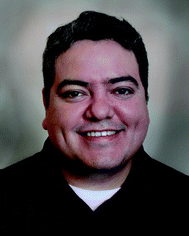JAAS Emerging Investigator Lectureship
On the occasion of the 30th anniversary of the journal, it was decided to launch the JAAS Emerging Investigator Lectureship. This lectureship will be awarded annually and aims at recognizing and supporting an emerging scientist working in the area of atomic spectrometry in the early stages of his/her independent career.The editorial board was delighted to receive a very high number of nominations for this inaugural edition. As a result of the outstanding profile of most of the nominees, selecting the first winner was everything but self-evident. Even within the constraints described within the eligibility criteria (candidates are at an early stage of their independent career, typically within 10 years of completing their PhD), there was a wide variation in terms of post-doctoral experience and scientific output. These criteria were taken into account according to numerous normalization approaches, while using high-end chemometrics and validation approaches to come to a final decision. Alas, the editorial board failed in its endeavor to select “a” winner, but came up with two, Dr Lara Lobo from the University of Oviedo (Spain) and Prof. Dr Gerardo Gamez from Texas Tech University (USA). Congratulations to both deserved winners!
The recipients of the JAAS lectureship will present their recent research results at a JAAS session at the next Pittcon conference in Atlanta in March and receive a contribution to cover associated travel and accommodation costs from the RSC. They were awarded a certificate and were asked to contribute a perspective or research article to JAAS. You will find the papers they have submitted in this issue of JAAS.
Ladies first. Lara Lobo obtained her BSc and MSc degrees at the University of Oviedo in Spain. She carried out PhD studies at the same university in the research group of Prof. Dr Alfredo Sanz-Medel. Lara's PhD research was focused on the development of a novel type of rf glow discharge mass spectrometer, equipped with a time-of-flight mass spectrometer. After successfully completing her PhD, for which she received the Extraordinary Doctorate Award from the university (2011), she obtained a Marie Curie 2 years postdoctoral fellowship from the European Research Council and joined my research group at Ghent University (UGent) in Belgium, where Lara changed gears and developed novel methods based on multi-collector ICP-mass spectrometry (MC-ICP-MS) for high-precision isotopic analysis of elements such as Cu and Sb, which were deliberately added to ancient glass for imparting color and/or opacity, for provenancing purposes. With funding from the Belgian Science Policy (Belspo), Lara was able to extend her activities at UGent and during that stage, she developed various analytical methods for the analysis of meteorite material. Subsequently, she returned to the University of Oviedo, where she currently holds a Marie Curie – Clarin co-fund postdoctoral position. Her research scope has meanwhile widened and her work involves method development with rfGD-ToFMS, laser ablation ICP-MS and MC-ICP-MS.
Lara Lobo
Gerardo Gamez obtained his BSc and MSc degrees at the University of Texas at El Paso. He carried out PhD studies at Indiana University (IU) in the research group of Prof. Dr Gary Hieftje. Gerardo developed Thomson and Rayleigh laser scattering instrumentation for studying the fundamental properties of the inductively coupled plasma. He contributed to the invention of a plasma-based ambient desorption/ionization (ADI) source and of a surface elemental tomography technique based on glow discharge optical emission spectrometry (GDOES). He won several IU-internal and external awards for his work. After obtaining his PhD degree (2006), Gerardo crossed the Atlantic Ocean and joined the research group of Prof. Dr Renato Zenobi at the ETH-Zürich (Switzerland) as a postdoctoral associate, where he developed a method based on ADI-MS for exhaled breath analysis in a biomedical context and contributed to the solving of other analytical challenges. Apparently still impressed by the beauty of the Swiss Alps, he subsequently joined the Swiss Federal Laboratories for Materials Sciences (EMPA, Thun) as a Senior Scientist, where he worked on glow discharge approaches for ultra-high throughput surface analysis of cm2-sized surfaces. Gerardo is currently an Assistant Professor at Texas Tech University, where he focuses on the development of surface chemical imaging techniques via optical spectroscopy and mass spectrometry, and ADI sources.
Gerardo Gamez
This issue of JAAS features a research paper from each of our JAAS lectureship winners. Lara reports on the use of positive and negative ion modes in the context of molecular screening in polymeric materials using radiofrequency pulsed glow discharge time of flight mass spectrometry. As both atomic information (hetero-elements) and molecular information can be gathered in this way, Lara has single-handedly illustrated the need for the recent JAAS scope revision. Also Gerardo's paper features the glow discharge, but as a source for optical emission spectrometry, a combination he uses for elemental mapping with restrictive anode array masks (RAAMs). These RAAMS provide the homogeneity required for chemical imaging of large surface areas with high sample throughput.
I trust that you will enjoy reading both papers and would like to invite all of you who will be at Pittcon this year to attend the session organized by JAAS to honor our Emerging Investigator Lectureship winners and to hear both of them present their work on stage.
Finally, I wholeheartedly congratulate both winners and wish them a splendid career, preferably in the field of atomic spectrometry!
Frank Vanhaecke
Chairman of the Editorial Board
| This journal is © The Royal Society of Chemistry 2016 |


